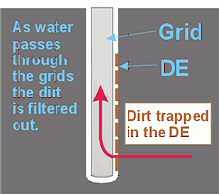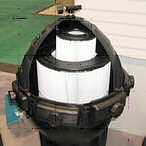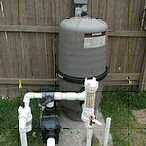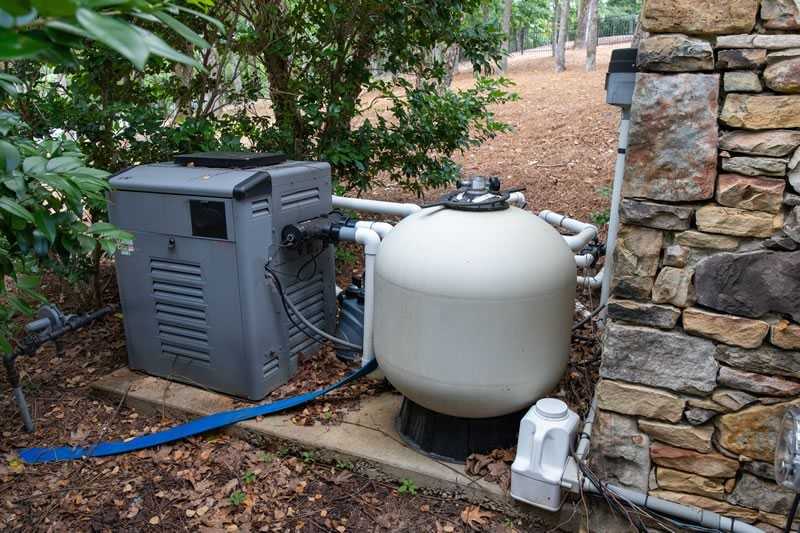D.E. Filters
A DE filter offers the best possible filtration, but it also requires the highest level of maintenance. DE filters are also not very forgiving of poor maintenance practices. The filters need to be backwashed at proper intervals and the pump sizing and filter cycles need to be accurate.

The water enters the filter through the lower bulkhead fitting. It enters the bottom of the tank and enters the grids (see close-up view). The DE on the grids serves as the filter media. The water passes through the DE and grid canvas to the inside of the grid. The water passes up through the inside of the grids into the upper manifold. The water then goes down the standpipe to the manifold and out through the backwash valve. The air relief tube serves to continuously remove air pockets from the top of the filter. The air relief valve offers a way to manually remove an air pocket in the filter.
Cartridge Filters


The cartridge filter is just about the least expensive form of filter there is and also the easiest to maintain. It because quite unpopular with service guys in the early 80’s because the older ones had dozens of little cartridges and frankly they were a nuisance to clean. Today’s cartridge filters generally have 4 or fewer cartridges and boast total filter areas of 300 – 500 square feet, thus requiring cleaning less often.
The water enters the filter through the upper bulkhead fitting. It passes through the diffuser which causes it to circulate evenly around the cartridges. As the water passes through the cartridges , debris in the water is trapped by the filter material. The cartridges are pleated to allow each cartridge to hold 100 feet or more of filter area. The water exits the cartridges at the bottom and returns to the pool through the lower bulkhead fitting. No backwash valve is need on this type of filter. A lateral assembly at the bottom of the filter collects the water and returns it to the pool. The air relief tube serves to continuously remove air pockets from the top of the filter. The air relief valve offers a way to manually remove an air pocket in the filter.
Today’s cartridge filters filter more finely because the flow rate per square foot of filter material is much less. The slower the water flows through the filter media, the better it will filter. Cartridge filters remove particulate down to about 20 microns in size.
Sand Filters:
The sand in a pool sand filter (#20 silica sand; 45 – 55 mm) is specially graded to trap particles in the 20 – 100 micron range. As a sand filter collects dirt, its efficiency increases, trapping more dirt. When your pressure gauge shows a reading 8 – 10 lbs. over the clean, start-up reading, it is time to backwash the captured dirt out of the filter.
Sand filters are known to be the lowest maintenance of the three types of pool filters. You may only need to open up the tank every 5 years or so. DE filters require removing the internal grid assembly at least annually to clean them well, and cartridge filters don’t backwash, you remove the cartridge and hose clean every so often, depending on the cartridge filter size. Sand filters are the easiest to operate and maintain.
“They say” that the sand inside a sand filter should be replaced after seven years. Gradual loss of efficiency may be hard to notice. If your sand filter requires frequent backwashing, every week or two, the sand bed may be “mudballed”, or it may be “channeled”. It may also “calcify” with calcium deposits. Other water balance problems may also contribute to pool filter sand deterioration, but a properly sized sand filter could go over 10 years between sand changes.
Use of Biguanide chemicals, i.e., Soft Swim or Baquacil require annual cleaning of the filter sand to prevent it from “gumming-up”. High amounts of bather oils can gum-up a sand bed. And just the years of a pump forcing water over the grains wears away the sharp edges of the sand. Such pool filter sand becomes more circular, and traps dirt less efficiently.
Remember that for sparkling water, we need the trio of sanitation, filtration and circulation. If one of these areas is lacking, the water won’t look so good. So, if you’ve kept very good chemical maintenance and your circulation is good, you may have a filter problem. Is the filter sized properly? Many filters of the 70’s – 80’s were grossly undersized, the trend now in pool filtration is “Go Big Early.” In ground pools should have a 3.1 sq ft sand filter or greater.
Adding a small amount of aluminum sulfate or “alum”, through the skimmer will form a gelatinous layer on top of the sand bed, useful in cleaning up an undesirable water condition. You can also add a small amount of D.E. powder or other filter media.
Pool Filter Sizing
Once you have chosen the right type of filter for your pool, it is important to get it sized properly. It must be sized to match the pump which in turn must match the circulation needs of the pool. If the filter is undersized, it will fill up quickly and also can be damaged by the force of the pump. If the filter is undersized, it may not backwash well.
It is important to keep in mind that the manufacturer’s flow ratings for filters are often very optimistic. Our experience suggests that the following guidelines are much more realistic.
On-site analysis must be done to insure that the filter matches up properly with the pump and the pool. For instance, if the plumbing runs on the equipment are particularly long, then the resistance to flow in the piping will be greater and intake lines may need to be larger than specified in this chart.
Note also that this may differ from the recommendations listed by the manufacturer .
The literature may indicate that it is OK to match up a 2.5 or 3.0 hp pump to a 60 square foot DE filter, but we never recommend it because we have seen plenty of DE filter grids blown out by these larger sized pumps. It is always better to oversize the filter. With an oversized filter, the water flows through the filter media at a slower velocity and that results in finer filtration and longer filter cycles.
Some builders will install a 3.0 hp filter pump on a pool/spa combination in order to give maximum water flow through the spa jets.
This is nice except for the fact that the pump is so powerful that it has the potential to damage the grids in the filter. The better way is to install a smaller filtration pump for the pool and then run a separate booster pump. This keeps you from having to run a large 3.0 hp pump every day on the normal filter cycles.
See also the pump sizing section
Backwash Valves
The backwash valve directs the flow of water through the filter. There are two main types of backwash valves. The simplest is the push-pull valve (known as plunger valve) and the other is the multiport valve (known also as a dial valve). Some filters (Purex) have a bottom mounted valve, but they are less common.


